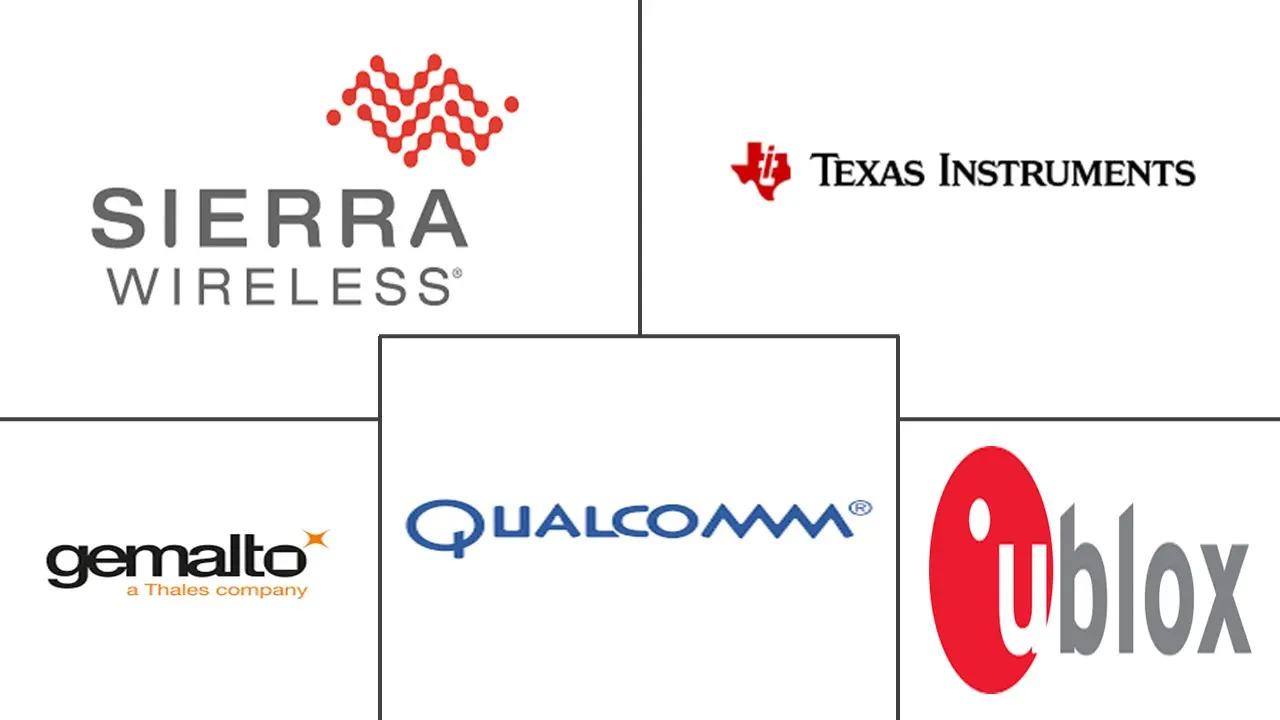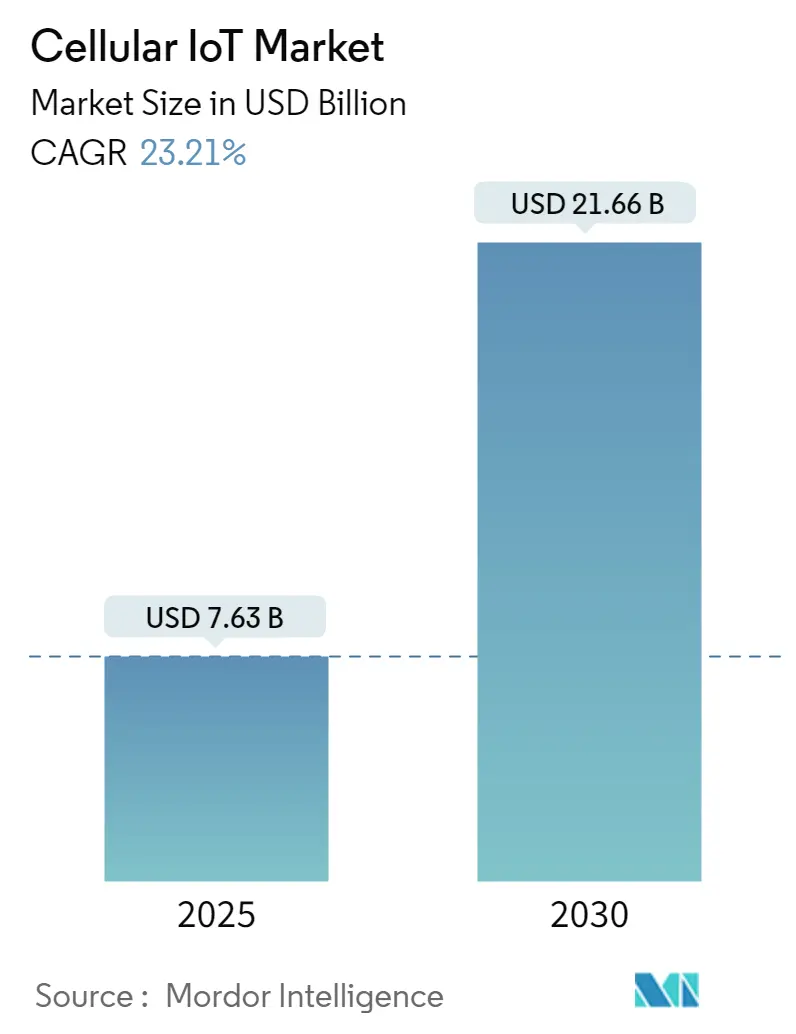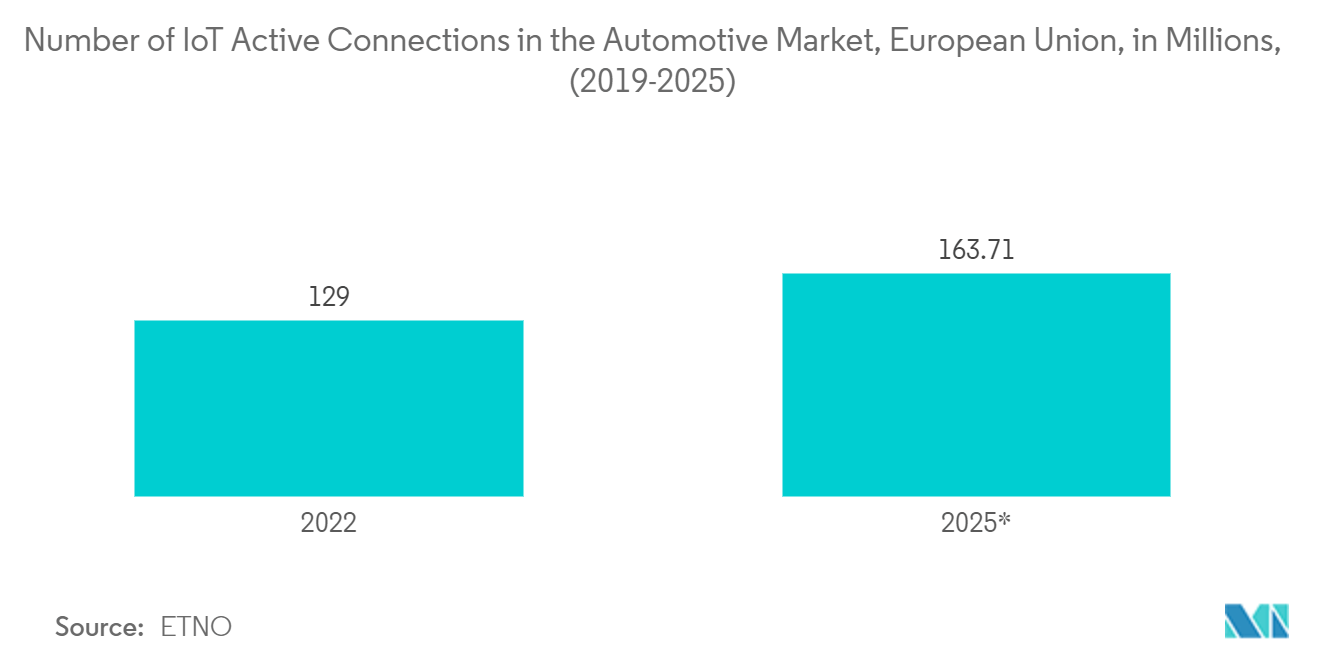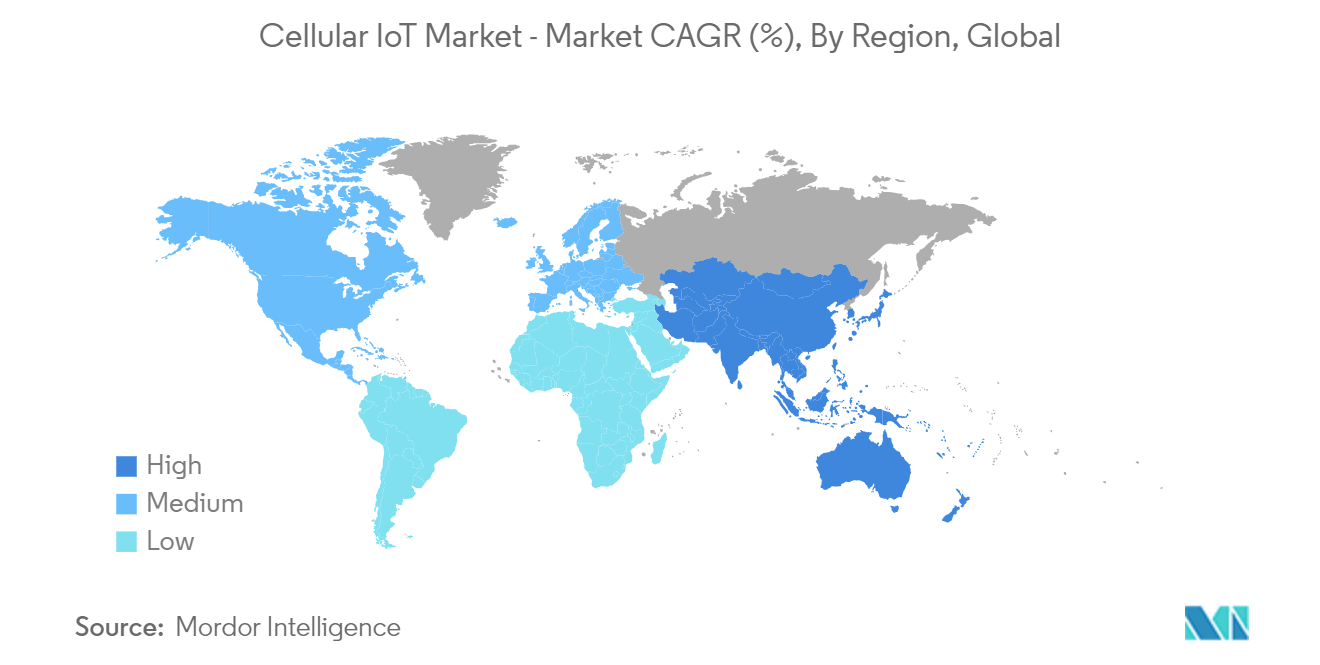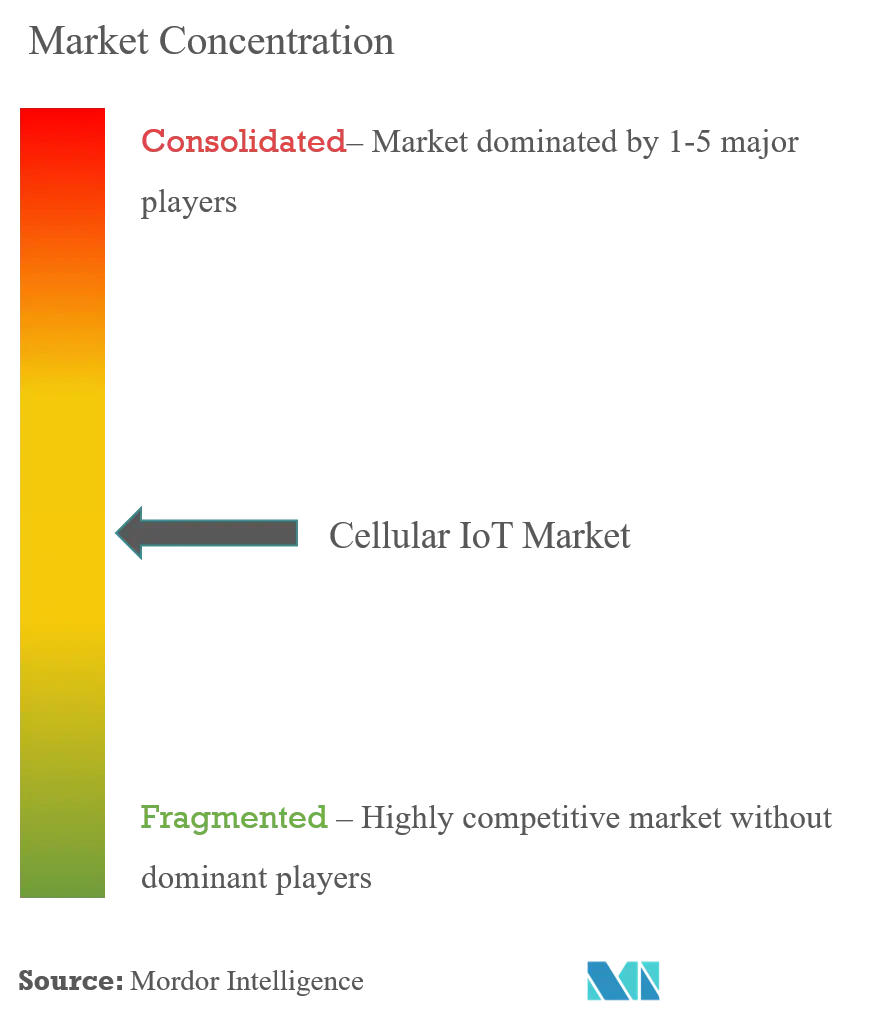Cellular Internet of Things (IoT) Market Analysis
The Cellular IoT Market size is estimated at USD 7.63 billion in 2025, and is expected to reach USD 21.66 billion by 2030, at a CAGR of 23.21% during the forecast period (2025-2030).
- The presence of rapidly growing nations, rising adoption of advanced technologies, and an increasing number of connected devices are some of the major factors expected to fuel the global growth of cellular IoT.
- The rise in digitalization and automation across industries such as manufacturing, automotive, and energy & utilities are expected to drive the global cellular IoT market growth. Furthermore, increased demand for extended network coverage, increased inclination towards business expansion beyond mobile broadband, and the need to accommodate a large number of connected devices among businesses worldwide are some of the major factors expected to propel the growth of the cellular IoT market.
- The growing adoption of IoT in the automotive industry, the commercialization of 5G, and the emergence of Narrowband Internet of Things (NB-IoT) and Long Term Evolution for Machines (LTE-M) are some factors expected to benefit the cellular IoT market players.
- The growing demand for end-to-end security, such as device-level solid access and authentication, encrypted data transport, and so on, is driving the global cellular IoT market, as cellular IoT solutions provide a robust infrastructure that helps businesses minimize risk and maximize uptime.
- The coronavirus outbreak and its consequences slowed cellular IoT investment and deployment and extended timelines for cellular IoT market growth in many sectors. However, with major disruptions in global healthcare and supply chains, governments, hospitals, insurers, and logistics providers reacted quickly and rethought how a more connected world helped better address the current crisis and avert or mitigate future ones.
- Businesses around the world had either moved to WFH (work-from-home) environments or were operating under conditions that were far from normal. In addition, the world's fixed broadband infrastructure trembled due to a massive increase in video conferencing and video content streaming.
Cellular Internet of Things (IoT) Market Trends
Increasing demand of cellular Iot for C-V2X in automotive sector to Drive The Market
Cellular Vehicle-to-Everything (C-V2X) in the automotive sector is growing due to increased demand for safe and dependable road transportation, rising adoption of autonomous vehicles, and rising adoption of vehicle telematics by logistics and transportation companies. The increasing demand for highly reliable, real-time communication at high speeds and in high-density traffic and leveraging the comprehensive coverage of secure and well-established LTE networks are driving demand for C-V2X cellular IoT. The advancements in 5G technology would enable the applications of 5G-V2X, which is expected to offer better cybersecurity performance and handle many messages in congested traffic environments. Another factor driving the cellular IoT segment is the cost of hardware components.
For instance, in the previous year, Verizon and Nissan completed a proof-of-concept project demonstrating the powerful synergy of edge computing over 5G and C-V2X. (Cellular Vehicle-to-Everything). For the experiment, data collected from roadside infrastructure and onboard vehicle sensors were analyzed at the Verizon network's edge. Following processing, the data was quickly transmitted back to the vehicles for urgent driver notifications.
Asia-Pacific To Register Highest Market Growth
Asia-Pacific is anticipated to be the fastest-growing market of cellular IoT due to countries such as China and India having a large pool of semiconductor dealers. Furthermore, the growing influx of technology companies in the region and increased investment in IoT technology are expected to accelerate market growth.
Governments in Asian countries such as India are also interested in the cellular IOT market and are launching numerous smart infrastructure projects. Governments in India, Japan, China, Korea, Malaysia, and Singapore have promoted national cellular IoT strategies, which are expected to boost the growth of the cellular IoT market in these countries.
The growing use of smart meters and grids fuels the expansion of cellular IoT modules in the region's energy industry. Furthermore, the expansion of energy management, combined with rising demand for green homes, drives overall demand for the building automation market, resulting in high demand for cellular IoT deployment.
For APAC enterprises, key strategic IoT drivers are cost and efficiency, with data/network security and ongoing costs posing major challenges. Global cloud and IT vendors are emerging as leading IoT providers in APAC, adding fuel to the region's market.
While data/network security and ongoing expenditures are the primary concerns, cost and efficiency are the key strategic IoT drivers for APAC businesses. Spending on enterprise IoT is also relatively low in APAC. International cloud and IT vendors are quickly becoming the top IoT providers in APAC due to their best-in-class technology and integration capabilities.
Cellular Internet of Things (IoT) Industry Overview
The cellular internet of things (IoT) market is semi-consolidated due to a few large and small players in both domestic and international markets. Because of a few technological behemoths, the market appears to be semi-consolidated. Product innovation and mergers and acquisitions are key market strategies the major players employ. The following are some of the market's most significant developments:
In February 2023, Qualcomm, a US mobile chip company, launched a new platform Qualcomm Aware, a cloud-friendly bundle that includes Qualcomm silicon and an ecosystem of hardware and software partners. The concept appears to be a one-stop shop for all types of IoT projects overseen by Qualcomm. Furthermore, "Qualcomm Aware is designed to provide organizations across industries with a scalable, cost-effective, capital-efficient investment solution that accelerates time to market, simplifies digital transformation, and delivers transformative insights needed to reduce risk, make more informed business decisions, and navigate cross-industry challenges."
In November 2022, Quectel Wireless Solutions, a global IoT and automotive solutions provider, announced the release of its new AG18 automotive module, one of the next generation of cellular vehicle-to-everything (C-V2X) modules. With PC5 direct communications, the module allows vehicles to communicate with one another and with their surroundings effectively, ensuring improved safety and traffic efficiency.
Furthermore, the AG18 supports vehicle-to-vehicle (V2V), vehicle-to-infrastructure (V2I), and vehicle-to-pedestrian (V2P) communications on the unified 5.9GHz intelligent transportation system (ITS) band without the need for a (U)SIM, cellular subscription, or network assistance. In addition to superior C-V2X communication capabilities, the AG18 module includes flexible positioning service options such as L1+L5 dual frequency GNSS, Qualcomm Dead Reckoning (QDR3), and high-precision PPE (RTK), ensuring that global automotive OEMs and Tier 1 suppliers can leverage location technology appropriate to their application requirements.
Cellular Internet of Things (IoT) Market Leaders
-
Qualcomm Technologies Inc.
-
Texas Instruments Incorporated
-
Gemalto N.V.
-
Sierra Wireless
-
U-Blox Holding AG
- *Disclaimer: Major Players sorted in no particular order
Cellular Internet of Things (IoT) Market News
- January 2023: Sierra Wireless, a Semtech Corporation subsidiary and IoT solutions provider, announced the launch of Smart Connectivity Premium with eUICC capabilities and expanded connectivity coverage in the United States. Moreover, with its multi-IMSI, multi-profile design enabled by GSMA eSIM (eUICC) specifications, Smart Connectivity Premium provides resilient IoT-managed connectivity that is future-proofed across geographies and technologies with a single global SIM. The SIM dynamically switches between profiles and networks when one becomes unavailable, providing maximum coverage and built-in failover in over 190 countries. It also gives customers access to all three major carrier networks in the United States.
- May 2022: Audi, a German luxury vehicle manufacturer, provided an update on its work with mobility platform Spoke and other partners to use cellular vehicle-to-everything (C-V2X) technology to help prevent accidents between bikes and cars. Moreover, Audi collaborated with C-V2X, which uses LTE cellular signals and direct PC5 signals that do not require a cellular network to detect a cyclist, school bus, or emergency vehicle and alert the car's driver.
Cellular Internet of Things (IoT) Industry Segmentation
Cellular IoT is defined as a way of connecting physical devices to the internet across the globe. These advanced technologies used for connectivity comprise 3G, 4G, 5G, and LPWA (Low Power Wide Area) cellular technologies such as NB-IoT and LTE-M. It offers benefits such as global coverage, reliable connection of IoT devices, and low-cost hardware that are requirements for cellular IoT connections.
The Cellular IoT Market is segmented by component (Hardware, Software), network type (2G, 3G, 4G, 5G, LTE-M, NB-LTE-M, NB-IoT), by end-user (Retail, Energy, Healthcare, Manufacturing, Consumer Electronics, Automotive, and Transportation) and by geography (North America, Europe, Asia Pacific, Rest of the World). The market sizes and forecasts are provided in terms of value (USD) for all the above segments.
| Component | Hardware |
| Software | |
| Type | 2G |
| 3G | |
| 4G | |
| 5G | |
| LTE-M | |
| NB-LTE-M | |
| NB-IoT | |
| End-User | Retail |
| Energy | |
| Healthcare | |
| Manufacturing | |
| Consumer Electronics | |
| Automotive & Transportation | |
| Other End-users | |
| Geography | North America |
| Europe | |
| Asia-Pacific | |
| Rest of the World |
Cellular Internet of Things (IoT) Market Research FAQs
How big is the Cellular IoT Market?
The Cellular IoT Market size is expected to reach USD 7.63 billion in 2025 and grow at a CAGR of 23.21% to reach USD 21.66 billion by 2030.
What is the current Cellular IoT Market size?
In 2025, the Cellular IoT Market size is expected to reach USD 7.63 billion.
Who are the key players in Cellular IoT Market?
Qualcomm Technologies Inc., Texas Instruments Incorporated, Gemalto N.V., Sierra Wireless and U-Blox Holding AG are the major companies operating in the Cellular IoT Market.
Which is the fastest growing region in Cellular IoT Market?
Asia Pacific is estimated to grow at the highest CAGR over the forecast period (2025-2030).
Which region has the biggest share in Cellular IoT Market?
In 2025, the North America accounts for the largest market share in Cellular IoT Market.
What years does this Cellular IoT Market cover, and what was the market size in 2024?
In 2024, the Cellular IoT Market size was estimated at USD 5.86 billion. The report covers the Cellular IoT Market historical market size for years: 2019, 2020, 2021, 2022, 2023 and 2024. The report also forecasts the Cellular IoT Market size for years: 2025, 2026, 2027, 2028, 2029 and 2030.
Our Best Selling Reports
Cellular IoT Industry Report
Statistics for the 2025 Cellular IoT market share, size and revenue growth rate, created by Mordor Intelligence™ Industry Reports. Cellular IoT analysis includes a market forecast outlook for 2025 to 2030 and historical overview. Get a sample of this industry analysis as a free report PDF download.

